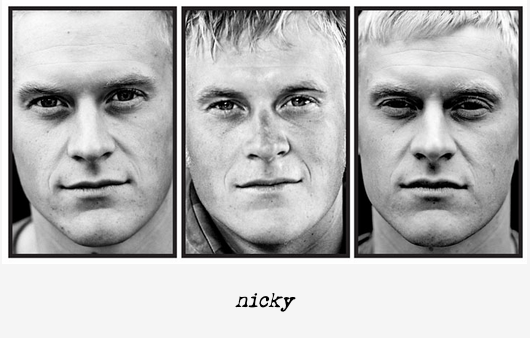"Nicky," Here Are the Young Men, Claire Felicie, 2009–2010
When I write here of beauty, most of the time I’m actually writing of convention—of what we as a culture have given our stamp of approval in the realm of beauty. The point isn’t any person’s actual appeal; the point is the standards and parameters we create around beauty.
But the way I experience beauty in my day-to-day life is personal, not sociological. When I register someone as beautiful—that is, when a person shows up on my radar as you should continue to look—it’s because of a quality the person has. A flicker in the eyes, a smirk, the way the person moves. That sounds vague because it is vague, it has to be vague, because if it were charted and fully understood, it might lose its properties of fascination. Beauty’s ineffability is part of what makes it register to us as beauty.
It's that elusive transcendence—which may or may not be beauty—that comes to mind with Claire Felicie’s remarkable photographs of soldiers taken before, during, and after their tours of Afghanistan, titled Here Are the Young Men. If you saw these photographs absent of context, some of them might have that sort of unclassifiable but intriguing quality about them to you; others wouldn’t. But when you learn that these were taken before, during, and after a life-changing experience that most of us will thankfully never know for ourselves, other qualities leap forward. Aversion, deadening, patience, cynicism, hatred, weariness, reluctance: The photos reflect something more complex than a mere loss of innocence. The phrase “the fog of war” refers to the shrouding of facts, evidence, and ability to determine the best course of action that something as extraordinary as war brings. I think of it here because of these men’s faces: You can’t look at them and draw any sort of universal conclusion. Some men look like the grew into themselves during their tour, a sort of adultness settling across their face. Other men, afterward, are unable to look into the camera. There’s no one way to know how war will change any individual, or any nation.
These photos also call into focus the fluctuating gap between what we really see and what we expect to see, both overshadowed by our knowledge that predetermination will change what we see. As Heather Murphy writes on Slate’s photo blog, “[T]here is something else in that third picture; a dullness to the eyes, a stiffness to the jaw. Isn’t there? What’s interesting about this project is that you can convince yourself that someone changed dramatically from middle to right, only to compare right to left and talk yourself out of it. It must just be angle or lighting, you say.” Yet Murphy reaches the same conclusion I do: “But even after you’ve concluded that wrinkle isn't really any bigger, it's undeniable that there is a difference. … It's not about the obvious clues like a frown or matted hair, but something far more nuanced.”
This can be applied in a far broader context: How our assumptions regarding people’s experiences color how we visually perceive them. Those broader applications are worth looking at, but today, for once I’m not thinking of how to make these questions bigger. I’m thinking of the soldiers—the veterans—and their before, during, and after. Whatever any of us may think of the war in Afghanistan, these people were there fulfilling their duty—as many of our parents did in Vietnam, our grandparents in WWII, our great-grandparents in the Great War that made the eleventh day of the eleventh month a global call for peace, and a global remembrance of those who served. I don’t want to glorify war or its participants by commenting upon Veterans Day. But an honoring needn’t be one of glorification; it can be an honoring of experience. And today, we honor just that.
